Introduction
Today: A mechanical pencil from France, the BIC Matic Classic 0.7mm. Probably their most simple pencil [1]On the high-end of BIC’s spectrum you’d find the BIC AI and the BIC Rondo, which has been removed from local shops and from their catalogue, so I assume you will only be able to get the … Continue reading. It’s main advantages, according to the packaging (click on the images of the packaging to enlarge, the thumbnails are rather small):
- No need to sharpen and
- Writes 2x nore than a graphite pencil.
Value for money
In April I bought a pack with three pencils in my local Morrisons (a supermarket chain from the North of England) for £1.50 (~$2.30; €1.75). £1.50, that’s very cheap – per pencil it’s cheaper than a typical, branded woodcased pencil. If you by the Matic in bulk you can get it even cheaper (i.e. ridiculously cheap). Other lead diameters (0.5 mm and 0.9 mm) and other looks (e.g. a girly, dotted version) are also available.
About the BIC Matic
 The clip colours of the “default version” currently on sale in Europe remind me very much of Lamy’s limited edition colours Aquamarine and Lime [2]The Lamy pens in these colours sell extremely well and are sought after. The BIC colours don’t match the Lamy colours exactly, but without a direct comparison they look pretty similar.. The colours used for the clips seem to have changed since this pencil has been reviewed by Pencil Revolution and Dave’s Mechanical Pencils, but the reason for the colour change might be geographical rather than temporal. I haven’t used this pencil in the past, but my pencils’ erasers perform very well, unlike Dave’s specimens. This could indicate that the quality of the eraser might have improved …or the quality of the eraser might vary depending on the origin of the pencil [3]It seems to be produced (or has been produced) in at least four different countries..
The clip colours of the “default version” currently on sale in Europe remind me very much of Lamy’s limited edition colours Aquamarine and Lime [2]The Lamy pens in these colours sell extremely well and are sought after. The BIC colours don’t match the Lamy colours exactly, but without a direct comparison they look pretty similar.. The colours used for the clips seem to have changed since this pencil has been reviewed by Pencil Revolution and Dave’s Mechanical Pencils, but the reason for the colour change might be geographical rather than temporal. I haven’t used this pencil in the past, but my pencils’ erasers perform very well, unlike Dave’s specimens. This could indicate that the quality of the eraser might have improved …or the quality of the eraser might vary depending on the origin of the pencil [3]It seems to be produced (or has been produced) in at least four different countries..
These pencils don’t seem to be as common in the UK or Germany as they are in the USA or New Zealand …or France, I noticed this pencil in the French TV series Spiral (Engrenages).
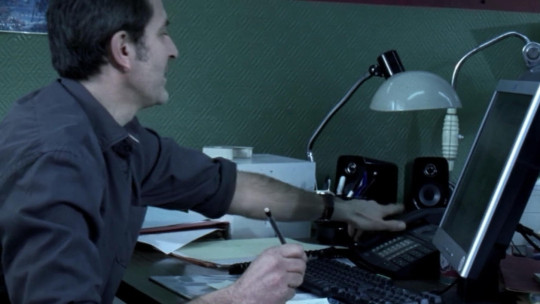
I’ve often seen similar looking, but different, pencils with a similar grip section supplied as no name stationery in offices or supplied as freebies usually with company logos printed on them, but the BIC Matic isn’t a common sight here.
Looking at them my first thought was that they’d be uncomfortable to hold because they are so slim, but actually they aren’t. With more than 8.0 mm at the grip section and more than 7.5 mm at the at the body their diameter is bigger than that of typical hexagonal pencils (7 mm edge to edge, 7.5 mm vertex to vertex).
What about the claim that this pencil writes 2x more than a graphite pencil? This might be an accurate claim for many users, but will largely depend on how you use your pencils [4]I’m taking the softness of the lead out of the equation. The provided lead seems to be a standard lead which behaves like many other HB leads). The length of the three leads per Matic added together is twice the length of the lead in a woodcased pencil. The “2x claim” is actually the same on the 0.5 mm and on the 0.9 mm version of BIC’s mechanical pencil, so it’s probably based on the overall length of the leads provided.
In reality your use would determine how much of the graphite you’re actually using. If you sharpen your woodcased pencil a lot you might not even use all of the central 0.7 mm of the lead, but if you don’t sharpen that often and rotate the pencil you might be using more than the central 0.7 mm of your pencil’s lead.

Want to double the 2x more?
If you see the statement “writes 2x more” as a personal challenge that you want to top this paragraph will explain what you need to do to double the BIC Matic‘s 2x writing with a normal, woodcased pencil. The trick is to use as much of the central part of the lead as possible. The central part you use should have a diameter of at least 1 mm. Done? Congratulations. You have now used twice as much of the lead (0.385 mm3 per mm of lead for the Matic compared to 0.785 mm3 for the woodcased pencil). In the following picture you can see a Black feet Indian Pencil with a diameter of more than 1 mm for the “unused” part of the “lead cone”. By rotating the pencil after every few words of writing the average writer should easily be able to produce a line of about 0.4 mm width, or even less if you rotate the pencil more often. You also wouldn’t want to waste graphite when sharpening, so if you really want to increase your use the graphite you could a sharpener with a point adjuster to avoid removing graphite from the central part of the lead [5]A great discussion of the percentage of graphite used in a woodcased pencil can be found at Lexikaliker.. A suitable sharpener is the Deli 0668 – other sharpeners with point adjusters are available from DUX, M+R, Dahle, Carl and other manufacturers. Finally, to avoid wasting the last few centimetres of the pencil: use a pencil extender.
There’s another argument in favour of the woodcased pencil: the typical mechanical pencil can’t use the last centimetre or so of a lead, just because of the way the grip mechanism works. You can find more information about this at Lexikaliker. Thanks to Sean‘s help I got my hand on a few Staedtler Integrity pencils a few years ago. The Integrity wastes less then 2 mm of the lead (the Matic wastes about 11 mm) [6]Unfortunately I didn’t succeed in using the Integrity to use up short bits of lead, feeding it already short bits of lead doesn’t really work.
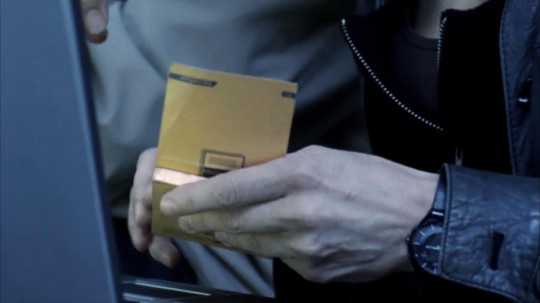
Since I mentioned Engrenages before and this blog post has a French theme: Laure, the main character in Engrenages is using an orange notepad, but unfortunately it’s none of the three I have shown in this blog (except the Rhodia there’s the Carrefour one and the Oxford one). I wonder how many how many people in France use the BIC Matic and how many different orange A7 notepads there are in France …
Price: April 2013
Exchange rates: June 2013
I’d like to thank Sean for the Blackfeet Indian Pencil seen in this blog post.
The screenshots in this blog post have been taken from episode 7 and episode 9 of the third season of Son et Lumière’s Engrenages. I believe that the use of the screenshots shown in this blog post falls under “fair dealing” as described by the UK Copyright service.
References
| ↑1 | On the high-end of BIC’s spectrum you’d find the BIC AI and the BIC Rondo, which has been removed from local shops and from their catalogue, so I assume you will only be able to get the Ballgraf version from now on. |
|---|---|
| ↑2 | The Lamy pens in these colours sell extremely well and are sought after. The BIC colours don’t match the Lamy colours exactly, but without a direct comparison they look pretty similar. |
| ↑3 | It seems to be produced (or has been produced) in at least four different countries. |
| ↑4 | I’m taking the softness of the lead out of the equation. The provided lead seems to be a standard lead which behaves like many other HB leads |
| ↑5 | A great discussion of the percentage of graphite used in a woodcased pencil can be found at Lexikaliker. |
| ↑6 | Unfortunately I didn’t succeed in using the Integrity to use up short bits of lead, feeding it already short bits of lead doesn’t really work |

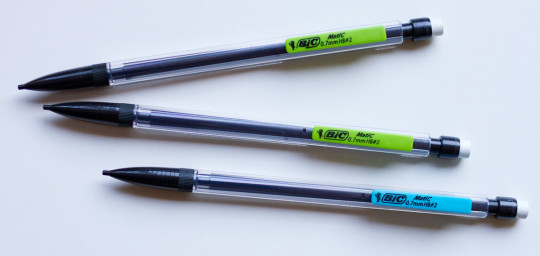
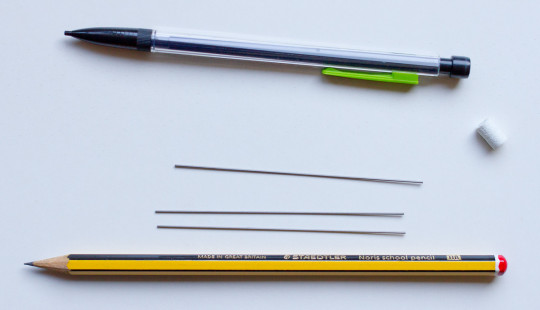
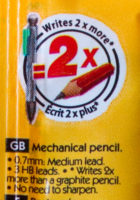
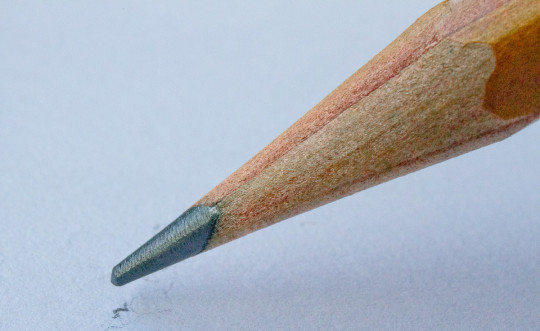
I think my children have an opaque version of this pencil, although my daughter much prefers the Wopex pencils she bought at Chapitre in Boulogne this year.
Hello John. Thanks for your comment. I’d be interested to know what colour the Wopex pencils have, just because there are quite a few different colours available now and I also wonder whether there are different colours in France.
Matthias, if you’re interested in more colors, I’ll gladly send you some. : ) We also have a yellow one around the US that I think is supposed to mimic a wooden pencil in color.
We had ugly tan and brown ones in the 80s when I was in school. They were hidious at the time, though they’d certainly go well with a set of Field Notes.
Thank you very much for the kind offer. I think my three BIC Matic will last a long time, so I don’t really need more of them. I had a look for fun and saw the yellow one you mentioned. To me it looks very much like a copy of the Paper-Mate Non-Stop / SharpWriter (link), but who knows, maybe it’s the other way round.
I got to try to find a photo of the hideous ones, maybe they’ll look fashionable again – it reminds me of some sport clothes and shoes (link) I had to wear in the mid-90s, they looked hideous at the time, but ten years later those colour and styles were in again.
Hi Matthias, I’ll raid her pencil case once I get back from work – the set we bought has a 2H, 2 or three HBs, and a 2B, I think, and each is a different colour (a different colour that I can’t remember just now 🙂 )
Ok, the Wopex we have are;
Blue (HB), an Orangey sort of Brown (2B) and Green (2H).
The pack on offer in Chapitre had one each of the 2H and 2B, and three HBs.
Following your tip, I sharpened them in the long point sharpener before returning them – a very odd feel in the sharpener indeed, although it works nicely for these.
I have seen these at work – no thanks. Interesting to see those barely-competent “flics” using Bics.
But more importantly, how lucky you are to get a Blackfeet Indian pencil! Nice one.
I’m really lucky to have some Blackfeet Indian Pencils, thanks to Sean.
I haven’t watched the new Spiral episodes yet, but I’ll keep my eyes open, maybe there’ll be more Bics…
I have fond memories of these pencils — alongside the Staedtler Noris, these were the pencils of my school days.
At the start of every term, I’d get a pack of six in my pencil case. I was always very excited to start using them. Back then they had black, slightly grainy erasers and an opaque black barrel. The clips varied, but were normally bright primary colours. The only downside was that the eraser never lasted as long as the lead in the pencil.
I used them through secondary school as well, and at some point during that time (1995-2001) they first started coming in other barrel colours. I always preferred the black ones, though.
I didn’t realise thay were popular in the UK at that time.
Did you ever refill them?
A lot of kids used them when I was at school, so I always saw them as pretty normal and didn’t consider them unusual.
I didn’t generally refill them, as often 0.7mm leads would cost the same or more than new Bic Matics, and I’d still have been stuck with a pencil that had a used-up eraser on the end. I did sometimes decant the leads from a couple of Matics into a single one, and put the erasers into my pencil case. I suppose this was an early attempt at streamlining my daily carry.
One downside of the pencils is that they would eventually stop advancing lead — I suppose the mechanism inside, never intended for long-term use, simply gave out. This only ever happened to me when I’d used more than the pencil’s original complement of lead.
I wonder why I never saw them as a kid. Maybe Bic didn’t sell them in Germany at the time..
I wouldn’t have expected that even back then they were already so cheap, i.e. not more than refills would cost.
What you said about them stopping to work soon after you exhausted the original leads is unexpected to me. I wonder whether it is actually planned obsolesence..
I lived in a relatively small town when I was growing up, and stationers tended to be quite conservative in what they carried. ‘Professional’ supplies like leads tended to be priced a little unreasonably. It wasn’t until I moved to another city for Uni that I first came across reasonably priced stationery, which was something of a revelation to me.
I’m not sure these are engineered to fail so much as they’re the result of engineering compromises to meet their price bracket. Being as heap as they are, it’s almost a certainty that the mechanism has compromises not found in a pencil intended for longterm use.
Have you ever tried any of the other sizes? I only ever saw these in 0.7mm, but it seems they’re also available in 0.5 and 0.9mm too.
I guess I have to count myself lucky in that in my small town stationery prices were reasonable.
With planned obsolesence I meant that they thought “How cheap can we make it so it the pencil will just last long enough with the original complement of leads”. I wonder whether you were in the small minority of people of ever refilled these.
I haven’t really tried the other sizes. 0.9mm would be too big for me, but I wouldn’t mind trying 0.5, just to have tried it. I wouldn’t use it regularly. If I see these in the UK, it’s usually 0.7mm though.
I suspect we were saying the same thing, but missing each other in the gaps between words. It’s interesting to wonder what the conversation and design process they followed to reach something that’s “just good enough”. Given how cheap they are, and how many I’m sure they produce every year, it’s quite incredible that they last as well as they do.
I haven’t tried either of the other sizes, and haven’t ever seen them for sale either — I saw them on eBay the other day whilst idly browsing. I’d perhaps like to try the 0.9, but I understand your preference for finer points.
You were lucky growing up with plentiful stationery nearby. I grew up in a ‘stationery desert’ that consisted of a the same few, sensible choices: Staedtler Norises (stamped “Made in Great Britain” at that time), Bic Matics, Bic and Papermate biroes, and Papermate and Pentel felt-pens. I remember as a child seeing artistic types using Staedtler Mars pencils, and that deep blue barrel was always associated with serious, creative people — which only made me want them more.
My secondary school art teacher, a flamboyant and slightly eccentric type who characteristically mispronounced French words for comic effect, used Derwents and guarded them jealously. She had a stock for the classroom, stored in an ice cream tub and counted out and back in as if they were precious antiques. Deliberately breaking one, as some classmates did, was to invite a serious bollocking, and rightfully so.
The last time I saw her, she was stoped over an ice cream tub, deep in concentration with her gigantic earrings touching the tip of her nose, counting the precious Derwents back into an ice cream tub. “Ow ree-voy-er, Mee-shell!” she said, not looking up, a soft clack each time she carefully put another pencil down on the stack.